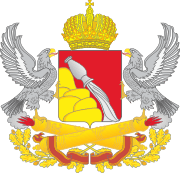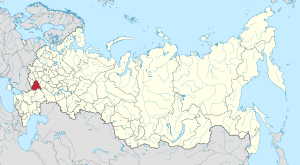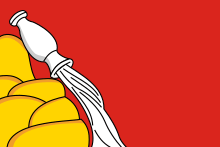Voronezh Oblast
Voronezh Oblast (Russian: Воронежская область, romanized: Voronezhskaya oblast) is a federal subject of Russia (an oblast). Its administrative center is the city of Voronezh. Its population was 2,335,380 as of the 2010 Census.[9]
Voronezh Oblast | |
|---|---|
| Воронежская область | |
 Coat of arms | |
| Anthem: [1] | |
 | |
| Coordinates: 51°03′N 40°09′E | |
| Country | Russia |
| Federal district | Central[2] |
| Economic region | Central Black Earth[3] |
| Established | June 13, 1934[4] |
| Administrative center | Voronezh[5] |
| Government | |
| • Body | Oblast Duma[6] |
| • Governor[6] | Alexander Gusev[7] |
| Area | |
| • Total | 52,400 km2 (20,200 sq mi) |
| Area rank | 51st |
| Population (2010 Census)[9] | |
| • Total | 2,335,380 |
| • Estimate (2018)[10] | 2,333,768 (-0.1%) |
| • Rank | 22nd |
| • Density | 45/km2 (120/sq mi) |
| • Urban | 63.7% |
| • Rural | 36.3% |
| Time zone | UTC+3 (MSK |
| ISO 3166 code | RU-VOR |
| License plates | 36, 136 |
| OKTMO ID | 20000000 |
| Official languages | Russian[12] |
| Website | https://www.govvrn.ru/ |
Geography
Voronezh Oblast borders internally with Belgorod Oblast, Kursk Oblast, Lipetsk Oblast, Tambov Oblast, Saratov Oblast, Volgograd Oblast and Rostov Oblast and internationally with Ukraine.
Voronezh Oblast is located in the central belt of the European part of Russia, in a very advantageous strategic location, transport links to the site going to the industrial regions of Russia. Within the radius (12 hours of driving 80 km/h) 960 kilometers around Voronezh more than 50% of the population Russia, and 40% in Ukraine live.
The area of the region - 52.4 thousand km2, which is about one third of the whole area of Central Black Earth Region. The length of the region from north to south - 277.5 km, and from west to east - 352 km. Much of the area is steppe, among the predominant soil fertile soil black earth.
Main rivers
.jpg)
The oblast has 738 lakes and ponds in 2408, in 1343 the river flows over 10 km long. The main river is the Don, 530 of its 1,870 km flows through the area, forming a drainage area of 422,000 square kilometers.
- Don
- Voronezh
- Bityug
- Khopyor
Climate

The climate in the region is temperate continental, with an average January temperatures of −4.5 °C (23.9 °F), and with an average July temperatures of +25 to +30 °C (77 to 86 °F). Average annual temperature varies from +5 °C (41 °F) in the north to +6.5 °C (43.7 °F) in the south. Precipitation varies from 600 millimeters (24 in) in the northwest to 450 millimeters (18 in) in the southeast.
Administrative divisions

Economy
The structure of Voronezh Oblast the industrial-agrarian. As part of the industry is dominated by mechanical engineering, power systems engineering, food industry, processing industry of agricultural raw materials. They account for 4/5 of the total volume of industrial output. Industry specialization of the region is the food industry (27%), second place is occupied by engineering and metalworking (23%), third place - power (18%).
Industry of the region specializes in the production of machine tools, oil and gas equipment, rocket engines, metal bridge structures, press-forging and mining equipment, electronic equipment, passenger aircraft Airbus.
The largest companies in the region include Sozvezdie (revenues of $414.81 million in 2017), Molvest (dairy industry; $293.11 million), Voronezhsintezkauchuk (Sibur group; $186.84 million), the Russian branch of COFCO Group ($161.12 million).[13]
Agriculture
Voronezh Oblast is a major supplier of agricultural products. For the first time in the history of farming region in 2011 produced record crops: sugar beet (factory) - 6 million. 992 thousand. Tons (3.9 times more than in 2010) and sunflower - 1 million. 002 thousand tons (2, 4 times more than in 2010) 2014 Voronezh Oblast ranked first in Russia in terms of gross harvest of potatoes, in farms of all categories have been collected 1.757 million tons of potatoes.
In general, the profile of agriculture - with crops of sunflowers and grain crops, dairy and beef cattle, pigs. Beet, sugar beet industry in Voronezh Oblast in terms of gross production of sugar beets and making sugar beet is one of the largest in the country. In 2014, sugar mills were produced 495.1 ths. tons of sugar.
Milk production in Voronezh Oblast in 2013 increased by 1.8% - up to 755,700. tons. In 2014, it increased by 4.2% to ↗788 000 tons, according to this indicator Voronezh Oblast takes first place in the Central Federal District. Milk yield per cow dairy herd in 2014 increased by 10.9% and amounted to 5545 kg.
Sights
Kostyonki, which is located within the Voronezh Oblast, is known for high concentration of cultural remains of anatomically modern humans from the beginning of the Upper Paleolithic era. The first and oldest camp rights in Europe. A layer of Campanian volcanic ash from about 40,000 years ago has been found above some of the finds, showing that "unknown humans" inhabited the site before this. The earliest directly dated human remains from this site are dated to 32,600 ± 1,100 14C years and consist of tibia and fibula, with traits classifying the bones to European early modern humans.
In 2009, DNA was extracted from the remains of a male hunter-gatherer who lived 40,000 years BP and died aged 20–25. His maternal lineage was found to be U2. He was buried in an oval pit in a crouched position and covered with red ochre.
Politics
During the Soviet period, the high authority in the oblast was shared between three persons: The first secretary of the Voronezh CPSU Committee (who in reality had the biggest authority), the chairman of the oblast Soviet (legislative power), and the Chairman of the oblast Executive Committee (executive power). Since 1991, CPSU lost all the power, and the head of the Oblast administration, and eventually the governor was appointed/elected alongside elected regional parliament.
The Charter of Voronezh Oblast is the fundamental law of the region. The Legislative Assembly of Voronezh Oblast is the province's standing legislative (representative) body. The Legislative Assembly exercises its authority by passing laws, resolutions, and other legal acts and by supervising the implementation and observance of the laws and other legal acts passed by it. The highest executive body is the Oblast Government, which includes territorial executive bodies such as district administrations, committees, and commissions that facilitate development and run the day to day matters of the province. The Oblast administration supports the activities of the Governor who is the highest official and acts as guarantor of the observance of the oblast Charter in accordance with the Constitution of Russia.
Demographics
Population: 2,335,380 (2010 Census);[9] 2,378,803 (2002 Census);[14] 2,469,766 (1989 Census).[15]
- Births (2012): 25 374 (Birth rate: 10.9)
- Deaths (2012): 36 174 (Death rate: 15.6)[16]
- Total fertility rate:[17]
2009 - 1.37 | 2010 - 1.36 | 2011 - 1.36 | 2012 - 1.45 | 2013 - 1.44 | 2014 - 1.47 | 2015 - 1.52 | 2016 - 1.48(e)
Ethnic composition (2010):[9]
- Russians - 95.5%
- Ukrainians - 1.9%
- Armenians - 0.5%
- Romani people - 0.2%
- Others - 1.9%
- 110,749 people were registered from administrative databases, and could not declare an ethnicity. It is estimated that the proportion of ethnicities in this group is the same as that of the declared group.[18]
Settlements
Religion
According to a 2012 survey[19] 62% of the population of Voronezh Oblast adheres to the Russian Orthodox Church, and 3.4% are unaffiliated Christians. In addition, 21.5% of the population deems itself to be "spiritual but not religious", 6% is atheist, and 7.1% follows other religions or did not give an answer to the question.[19]
Notable people
- Pavel Cherenkov, co-recipient of the 1958 Nobel Prize in Physics
- Alexandra Pavlovna Biryukova, 2nd woman appointed to the Politburo of the Communist Party of the Soviet Union
References
Notes
- Article 12 of the Charter of Voronezh Oblast, which enumerates the symbols of Voronezh Oblast, does not include an anthem, nor has a separate law establishing an anthem been adopted in the oblast.
- Президент Российской Федерации. Указ №849 от 13 мая 2000 г. «О полномочном представителе Президента Российской Федерации в федеральном округе». Вступил в силу 13 мая 2000 г. Опубликован: "Собрание законодательства РФ", No. 20, ст. 2112, 15 мая 2000 г. (President of the Russian Federation. Decree #849 of May 13, 2000 On the Plenipotentiary Representative of the President of the Russian Federation in a Federal District. Effective as of May 13, 2000.).
- Госстандарт Российской Федерации. №ОК 024-95 27 декабря 1995 г. «Общероссийский классификатор экономических регионов. 2. Экономические районы», в ред. Изменения №5/2001 ОКЭР. (Gosstandart of the Russian Federation. #OK 024-95 December 27, 1995 Russian Classification of Economic Regions. 2. Economic Regions, as amended by the Amendment #5/2001 OKER. ).
- Charter of Voronezh Oblast, Article 1
- Charter of Voronezh Oblast, Article 5
- Charter of Voronezh Oblast, Article 25
- Official website of Voronezh Oblast. Alexey Vasilyevich Gordeyev, Governor of Voronezh Oblast (in Russian)
- Федеральная служба государственной статистики (Federal State Statistics Service) (May 21, 2004). "Территория, число районов, населённых пунктов и сельских администраций по субъектам Российской Федерации (Territory, Number of Districts, Inhabited Localities, and Rural Administration by Federal Subjects of the Russian Federation)". Всероссийская перепись населения 2002 года (All-Russia Population Census of 2002) (in Russian). Federal State Statistics Service. Retrieved November 1, 2011.
- Russian Federal State Statistics Service (2011). "Всероссийская перепись населения 2010 года. Том 1" [2010 All-Russian Population Census, vol. 1]. Всероссийская перепись населения 2010 года [2010 All-Russia Population Census] (in Russian). Federal State Statistics Service.
- "26. Численность постоянного населения Российской Федерации по муниципальным образованиям на 1 января 2018 года". Federal State Statistics Service. Retrieved January 23, 2019.
- "Об исчислении времени". Официальный интернет-портал правовой информации (in Russian). June 3, 2011. Retrieved January 19, 2019.
- Official throughout the Russian Federation according to Article 68.1 of the Constitution of Russia.
- Выписки ЕГРЮЛ и ЕГРИП, проверка контрагентов, ИНН и КПП организаций, реквизиты ИП и ООО. СБИС (in Russian). Retrieved October 20, 2018.
- Russian Federal State Statistics Service (May 21, 2004). "Численность населения России, субъектов Российской Федерации в составе федеральных округов, районов, городских поселений, сельских населённых пунктов – районных центров и сельских населённых пунктов с населением 3 тысячи и более человек" [Population of Russia, Its Federal Districts, Federal Subjects, Districts, Urban Localities, Rural Localities—Administrative Centers, and Rural Localities with Population of Over 3,000] (XLS). Всероссийская перепись населения 2002 года [All-Russia Population Census of 2002] (in Russian).
- "Всесоюзная перепись населения 1989 г. Численность наличного населения союзных и автономных республик, автономных областей и округов, краёв, областей, районов, городских поселений и сёл-райцентров" [All Union Population Census of 1989: Present Population of Union and Autonomous Republics, Autonomous Oblasts and Okrugs, Krais, Oblasts, Districts, Urban Settlements, and Villages Serving as District Administrative Centers]. Всесоюзная перепись населения 1989 года [All-Union Population Census of 1989] (in Russian). Институт демографии Национального исследовательского университета: Высшая школа экономики [Institute of Demography at the National Research University: Higher School of Economics]. 1989 – via Demoscope Weekly.
- http://www.gks.ru/free_doc/2012/demo/edn12-12.htm
- http://www.gks.ru/wps/wcm/connect/rosstat_main/rosstat/ru/statistics/publications/catalog/doc_1137674209312
- http://www.perepis-2010.ru/news/detail.php?ID=6936
- "Arena: Atlas of Religions and Nationalities in Russia". Sreda, 2012.
- 2012 Arena Atlas Religion Maps. "Ogonek", № 34 (5243), 27/08/2012. Retrieved 21/04/2017. Archived.
Sources
- Воронежская областная Дума. 7 июня 2006 г. «Устав Воронежской области», в ред. Закона №96-ОЗ от 5 июня 2015 г. «О поправках к Уставу Воронежской области». Вступил в силу 20 июня 2006 г. Опубликован: "Коммуна", №87–88, 10 июня 2006 г. (Voronezh Oblast Duma. June 7, 2006 Charter of Voronezh Oblast, as amended by the Law #96-OZ of June 5, 2015 On the Amendments to the Charter of Voronezh Oblast. Effective as of June 20, 2006.).
External links

- (in Russian) Official website of Voronezh Oblast
- Central Eurasian Information Resource: Images of Voronezh Oblast - University of Washington Digital Collections
